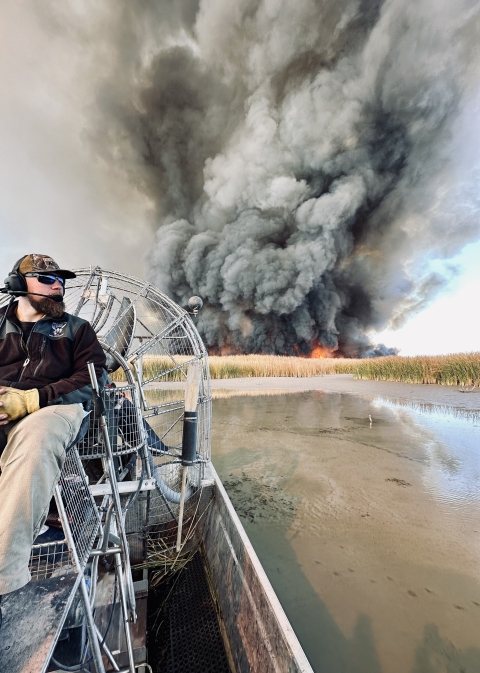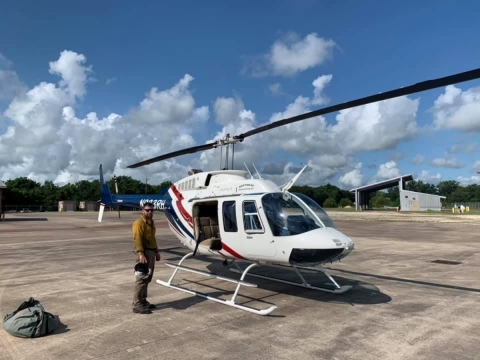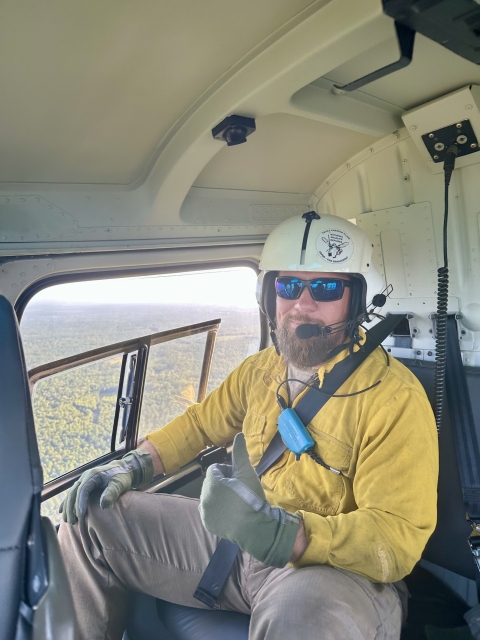Ron Deroche’s job as a Fuels Technician for the Texas Chenier Plain Fire Zone, which includes Anahuac, McFaddin, Texas Point, Moody, and Trinity River National Wildlife Refuges, is diverse. Although his job in the zone is always fundamentally a firefighter, his role also encompasses a variety of duties from assisting with prescribed fires, suppressing wildfires, maintaining and overseeing fuel reduction projects, repairing equipment, and helping refuge staff band waterfowl, and other duties as needed.
Ron is also a Plastic Sphere Dispenser Operator (PLDO) and often serves as one at his home unit. This role requires Ron to operate a Plastic Sphere Dispenser (PSD), a machine that releases plastic balls used to ignite natural material on the ground such as pine needles and grasses, also called fuel.
These spheres look very much like Ping-Pong balls but are filled with a granular substance. Just prior to being released by the machine, glycol is injected into each ball. Once on the ground and approximately 30-seconds after it is injected, the ball catches on fire and ignites the fuel (i. e., vegetation or leaf litter) on the ground. Ignitions of this type result in many small fires that grow together in a way that provides corridors for wildlife to escape and are more gentle on vegetation.
“When lighting a prescribed fire using a PSD, it happens very quickly,” said Ron. “You have to look four steps ahead when you’re doing aerial lighting because lighting large areas happens in a matter of minutes.” When operating the PSD, spherical balls are released at the rate in which the firing boss, who is also in the aircraft, determines. The rate of release can be adjusted, based on the desired fire activity.
In addition to timing the release of the spheres and fixing any jams, the potential for aerial hazards also needs to be monitored. The PSD is attached to the inside of a helicopter with a small portion partially outside the rear door. To adequately operate the PSD machine and watch out for sky hazards at the same time, Ron is situated partially outside the helicopter. During PSD operations, the door of the helicopter is removed to allow for better monitoring.
Prior to any type of burn, the aircraft is prepped for PSD operation. After installing, the machine is tested for safe operation. Settings are then adjusted on the machine to determine ignition time of the plastic spheres. After a thorough briefing, the operation is set to begin.
Once in the air, the helicopter is flown in a predetermined “box”, which is considered the firing unit. The helicopter will not leave the firing unit unless an emergency arises. The firing boss, seated in the front passenger seat of the helicopter, will guide the pilot throughout the firing unit.
After air and ground operations are complete, the helicopter will make one more pass over the burn unit to confirm objectives have been met, see if ground crews need help with any unburned spots, and to monitor the progress of the burn.
“The PSD has a tendency to jam, so you’re constantly filling it with spheres and fixing jams,” said Ron. “While you’re doing all this, you have to monitor fire activity, look for other aircraft, pay attention to nearby birds, and watch out for geographical hazards like mountains. You’re flying less than 200 feet above the treetops, so you have to be very situationally aware.”
When asked about airsickness, Ron laughs and says: “You’re constantly looking at the ground to assess where the spheres are landing, then back at the machine to make sure the spheres are shifting smoothly through. You look at the horizon when you can. You take sips of water. You look up from the ground when you know the helicopter is about to turn. That being said, every PLDO has either thrown up on a mission or gotten motion sick at one point or another.”
The number of spheres dropped during one operation depends on how long the helicopter flies and how big the area being lit is. Ron once flew several fuel cycles on a prescribed fire in Texas where he dropped 18,000 spheres over 15,000 acres during one operational period.
This year, Ron’s experience and qualifications allowed him to assist with wildfire suppression efforts in Canada. Ron assisted with lighting backburns using the PSD technique to create a controlled burned area ahead of the wildfire to keep it from spreading farther.






